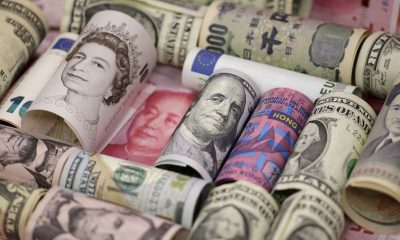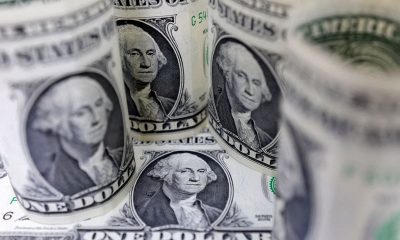Forex
Asia FX weak ahead of US inflation; yen dips as BOJ gives little support
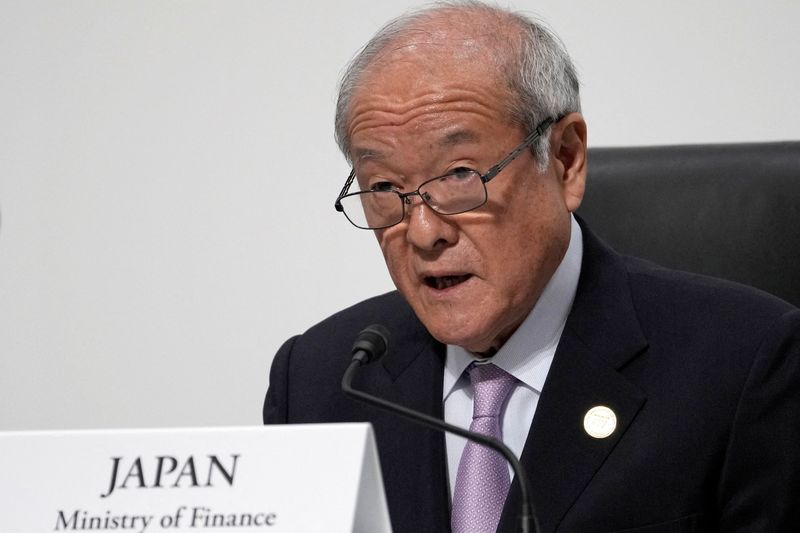
Investing.com– Most Asian currencies weakened on Friday, while the dollar steadied in anticipation of key inflation data that is expected to factor into the Federal Reserve’s stance on interest rate cuts.
While an overnight drop in the dollar- following weaker-than-expected U.S. gross domestic product data- offered some relief to Asian units, this was largely offset by persistent bets on higher-for-longer U.S. interest rates. The dollar also trimmed some of its losses in Asian trade.
Japanese yen weakens, USDJPY crosses 156 after BOJ
The Japanese yen was an underperformer, with the pair rising past 156 to new 34-year highs after comments from the Bank of Japan sparked doubts over just how much capacity the central bank had to raise interest rates further.
The BOJ after a historic hike in March. The central bank also forecast higher inflation in the coming years.
But the BOJ also , raising doubts over just how much capacity it would have to keep raising interest rates. This presented a largely dovish outlook for the yen.
Softer-than-expected – released earlier on Friday- further sparked doubts over a hawkish BOJ.
Still, losses in the yen were limited by continued fears of government intervention in currency markets. An upcoming press conference with BOJ Governor , at 02:30 ET (06:30 GMT) also presented the possibility of more hawkish signals.
Broader Asian currencies also weakened on Friday, amid persistent fears of higher-for-longer U.S. interest rates. The Chinese yuan’s pair rose slightly and remained close to recent five-month highs.
remove ads
.
South Korea’s pair rose 0.4%, while the Singapore dollar’s pair added 0.1%.
The Australian dollar’s pair was supported by strong inflation data, which, coupled with higher earlier this week, sparked bets on higher-for-longer rates in the country.
The Indian rupee’s pair moved little, with traders growing wary of more volatility in Indian markets as the 2024 general elections began.
Dollar steadies with PCE inflation on tap
The and rose marginally in Asian trade, recovering some overnight losses.
showed growth in the U.S. economy cooled more than expected in the first quarter, amid sticky inflation and high rates.
But inflation remained uncomfortably high, with the growing more than expected.
This put upcoming data squarely in focus. The reading is the Federal Reserve’s preferred inflation gauge.
Despite Thursday’s weak GDP reading, traders were seen steadily pricing out expectations for any near-term rate cuts by the Fed. The now shows traders pricing in rate cuts only by September, or the fourth quarter.
Forex
Dollar steady as US inflation data takes spotlight
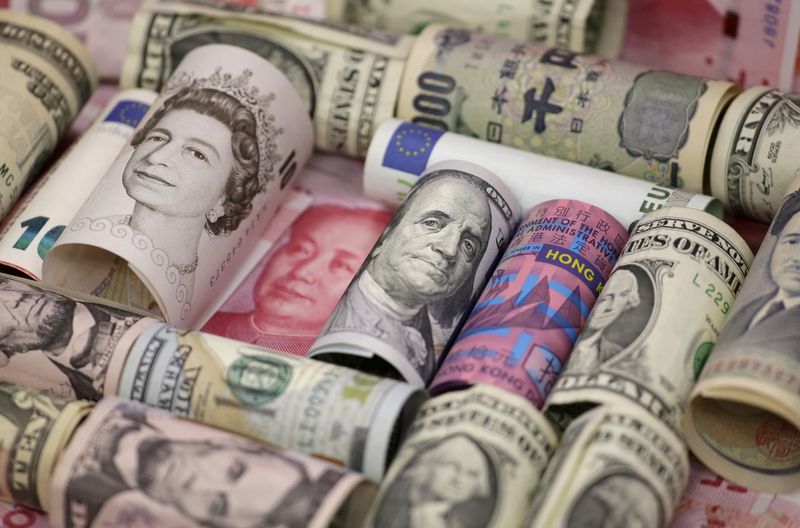
By Brigid Riley
TOKYO (Reuters) -The dollar consolidated against major peers on Monday as market participants awaited U.S. inflation data to assess the prospects of interest rate cuts this year.
After a softer-than-expected U.S. payrolls report for April and seemingly dovish Federal Reserve policy announcement earlier this month, expectations have increased for rate reductions this year.
Markets have priced in a 61.2% chance of some degree of rate reductions to begin at the Fed’s September meeting, with about 50 basis points of cuts in total expected, CME’s FedWatch Tool showed.
But comments by Fed officials last week were varied as speakers debated whether interest rates were high enough. A jump in consumers’ inflation expectations, revealed in a survey on Friday, could further complicate the conversation.
With recent data indicating the economy is slowing, investors are looking to confirm how sticky inflation is.
The market will have a chance this week, with inflation readings in the form of the producer price index (PPI) on Tuesday followed by the consumer price index (CPI) on Wednesday.
“For the wheels to truly fall off of the U.S. dollar, incoming data needs to point to disinflation, not just pockets of weakness here and there,” said Matt Simpson, senior market analyst at City Index.
“If inflation data ticks higher again this month it will surely undo the work of softer growth and slightly weaker employment figures.”
The , which measures the greenback against a basket of currencies, was flat at 105.31, following its first weekly gain last week after two successive weeks of decline.
remove ads
.
This week’s CPI will be crucial for the Federal Open Market Committee’s (FOMC) decision to start easing rates in September, said Carol Kong, a currency strategist at the Commonwealth Bank of Australia (OTC:).
“If we get a strong CPI this week, it will just leave the FOMC four more monthly CPI reports before the September meeting. I don’t think four benign CPI readings will give the FOMC enough confidence to start cutting rates in September.”
Fed Chair Jerome Powell will make an appearance on Tuesday at a meeting of the Foreign Bankers’ Association in Amsterdam.
INTERVENTION JITTERS
As markets look ahead this week to U.S. CPI, the yen won’t be far from traders’ minds amid an ongoing risk of currency intervention by Japanese authorities.
Against the yen , the dollar was holding solid at 155.80, after touching its highest since May 2 at 155.965.
The dollar has marched up against the yen after a 3% decline at the start of the month, its steepest weekly percentage drop since early December 2022, after two suspected interventions.
Those spikes of yen strength appear to have spooked some yen bears, at least for now.
Yen futures data from the CFTC showed non-commercial short positions have fallen sharply from the 179,919 contracts on April 23, which was the most since June 2007.
The currency received some support on Monday after the Bank of Japan sent a hawkish signal by cutting its offer amount for a segment of Japanese government bonds in the Asian morning.
remove ads
.
The euro was little changed at $1.07695 as the euro zone prepares for an inflation reading of its own on Friday.
Sterling was firm at $1.2522.
China’s slid 0.1% to 7.2414 while the fell to its lowest since April 30 at 7.2385, as traders awaited an announcement from the United States of new China tariffs.
At the same time, the Chinese central bank said over the weekend that new bank lending fell more than expected in April and broad credit growth hit a record low.
Separate data on Saturday showed Chinese consumer prices rose in April while producer prices extended declines.
The central bank pledged to support economic recovery.
In cryptocurrencies, bitcoin last rose 0.68% to $60,889.51.
Forex
Asia FX edges lower, dollar steadies with inflation on tap
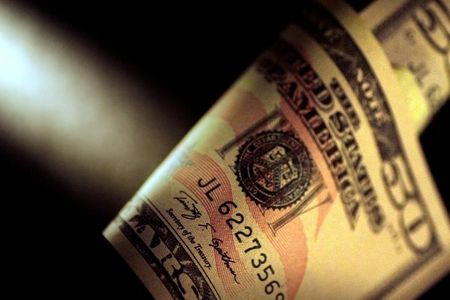
Investing.com– Most Asian currencies moved in a flat-to-low range on Monday, while the dollar steadied from recent swings as focus turned squarely to upcoming U.S. inflation data for more cues on interest rates.
Middling Chinese inflation data weighed on the yuan, while also sparking mild weakness in other China-exposed currencies.
Chinese yuan weak amid middling inflation, trade fears
The yuan’s pair rose 0.1% on Monday, hitting a two-week high after data released over the weekend offered mixed cues on Chinese inflation.
inflation rose more than expected in April, as persistent stimulus measures from Beijing helped buoy demand. But inflation shrank for a 19th consecutive month, as Chinese business activity remained laggard.
The inflation data showed that Beijing still had much more work to do in order to shore up economic growth.
Traders were also wary of China after reports last week said the Biden administration was preparing more trade tariffs against the country, especially on China’s electric vehicle sector. The move could reignite a trade war between the world’s largest economies.
Other China-exposed currencies clocked mild losses on Monday. The Australian dollar’s pair fell 0.1%, while the Singapore dollar’s pair rose slightly.
The South Korean won’s pair fell 0.1%.
Japanese yen treads water, on intervention watch
The Japanese yen moved little on Monday, with the pair hovering just below the 156 level.
Focus remained on any more potential government intervention to support the currency, following at least two instances of intervention earlier in May. The government was seen stepping in to bring down the USDJPY pair from 34-year highs above 160.
remove ads
.
While 160 is seen as the line in the sand for the government, analysts warned that intervention could still occur before that.
Dollar steady ahead of CPI data
The and moved little in Asian trade on Monday.
But traders remained largely biased towards the greenback ahead of key U.S. inflation data due later this week.
The – due on Wednesday- will be in close focus, given that it is likely to factor into the outlook for U.S. interest rates.
The dollar saw wild swings last week as mixed U.S. economic readings sparked questions over just when the central bank will begin cutting interest rates this year. But while the U.S. economy seemingly cooled in recent months, inflation is still projected to remain sticky.
Forex
Dollar up slightly after consumer sentiment data, CPI eyed
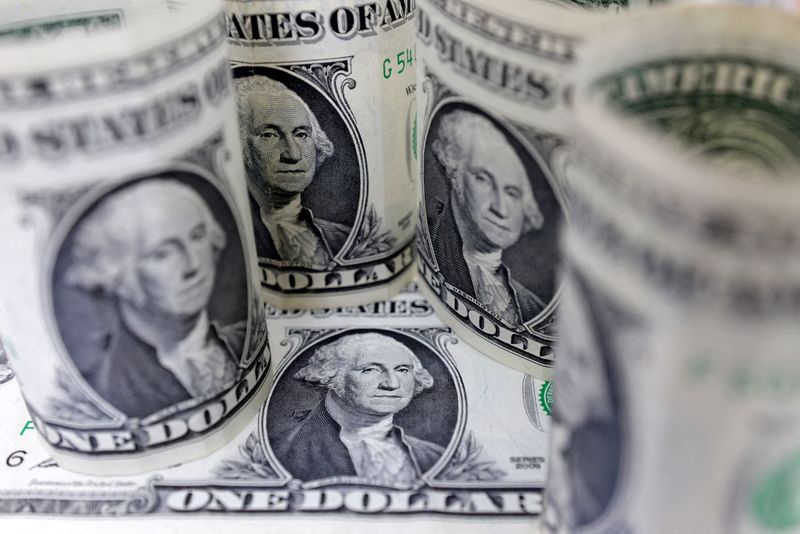
By Chuck Mikolajczak
NEW YORK (Reuters) -The dollar inched higher on Friday following a reading on U.S. consumer sentiment as investors sorted through a batch of comments from Federal Reserve officials, with the focus beginning to turn toward key inflation readings next week.
The greenback pared declines and turned modestly higher after the University of Michigan’s preliminary reading on consumer sentiment came in at 67.4 for May, a six-month low and below the 76.0 estimate of economists polled by Reuters. In addition, the one-year inflation expectation climbed to 3.5% from 3.2%.
The dollar had weakened on Thursday after a higher than expected reading on initial jobless claims fueled expectations the labor market was loosening, adding to other recent data that indicated the overall economy was slowing.
The , which measures the greenback against a basket of currencies, gained 0.09% to 105.31, with the euro down 0.08% at $1.0772. The dollar was on track for its first weekly gain after two straight weeks of declines.
Next week, investors will eye readings on inflation in the form of the consumer price index (CPI) and producer price index (PPI), as well as retail sales data.
“The CPI, I don’t think it’s going to change people’s views; the price pressure is still elevated, but it’ll be a decline, it will be just a softer year-over-year read,” said Marc Chandler, chief market strategist at Bannockburn Global Forex in New York.
“So it’s not so much the magnitude, but the direction.”
remove ads
.
Also supporting the dollar were comments from Dallas Federal Reserve President Lorie Logan, who said it was not clear whether monetary policy was tight enough to bring inflation down to the U.S. central bank’s 2% goal, and it was too soon to be cutting interest rates.
That ran counter to earlier comments from Atlanta Federal Reserve President Raphael Bostic, who said the Fed likely remained on track to cut rates this year even if the timing and extent of the policy easing was uncertain. In addition, Chicago Federal Reserve President Austan Goolsbee said he believes U.S. monetary policy is “relatively restrictive.”
The comments capped off a week of varying opinions among Fed officials as to whether rates are high enough.
Following last week’s softer than expected U.S. payrolls report and a Fed policy announcement, markets have been pricing in about 50 basis points (bps) of cuts this year, with a 62.2% chance for a cut of at least 25 basis points in September, according to CME’s FedWatch Tool.
Against the Japanese yen, the dollar strengthened 0.26% to 155.86 and was up about 1.9% on the week against the Japanese currency after it tumbled 3.4% last week, its biggest weekly percentage drop since early December 2022 after two suspected interventions by the Bank of Japan.
Japan’s Finance Minister Shunichi Suzuki said on Friday the government would take appropriate action on foreign exchange if needed, echoing recent comments from other officials.
Sterling edged up 0.02% to $1.2525 after earlier reaching $1.2541 in the wake of data showing Britain’s economy grew by the most in nearly three years in the first quarter of 2024, ending the shallow recession it entered in the second half of last year.
remove ads
.

 Forex2 years ago
Forex2 years agoForex Today: the dollar is gaining strength amid gloomy sentiment at the start of the Fed’s week

 Forex2 years ago
Forex2 years agoHow is the Australian dollar doing today?

 Forex1 year ago
Forex1 year agoUnbiased review of Pocket Option broker

 Forex2 years ago
Forex2 years agoDollar to pound sterling exchange rate today: Pound plummeted to its lowest since 1985

 Cryptocurrency2 years ago
Cryptocurrency2 years agoWhat happened in the crypto market – current events today

 World2 years ago
World2 years agoWhy are modern video games an art form?

 Stock Markets2 years ago
Stock Markets2 years agoMorgan Stanley: bear market rally to continue

 Economy2 years ago
Economy2 years agoCrude oil tankers double in price due to EU anti-Russian sanctions

